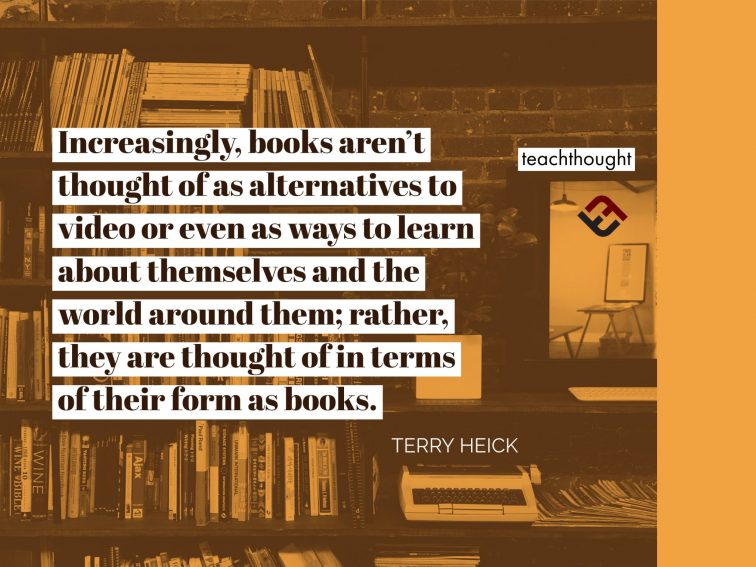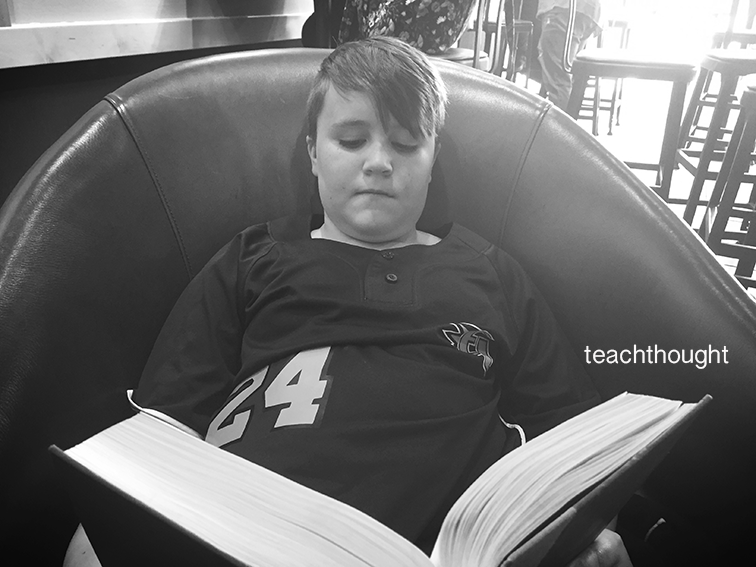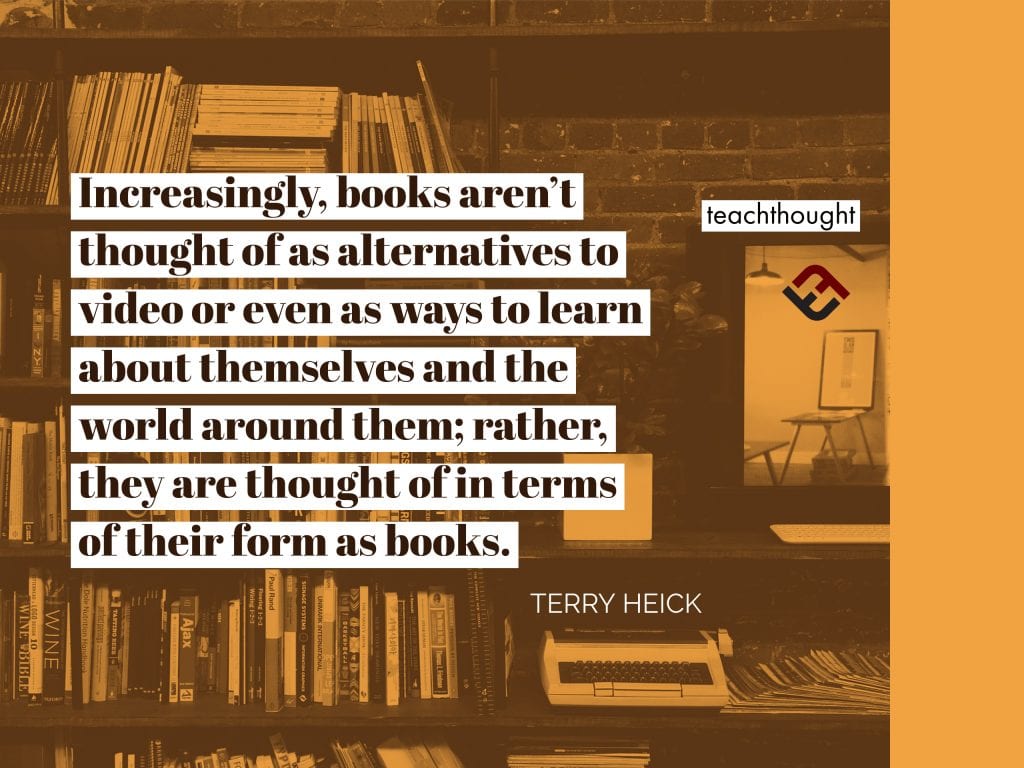
Why It’s Important To Teach Kids Why To Read
by Terry Heick
Preface: I’m writing under the assumption that the ‘child’ in question has access to some form of mobile technology, and that’s a problematic assumption that causes problems for my thesis, here. Nonetheless, addressing both ‘sides would require a far more extensive essay than I have time to research and write. Keep this distinction in mind if socio-cultural paradigms tangle the extraction of ideas for you.
The discussion around literacy is an ongoing storm that pulls in classic tenets like literature and modern ideas like digital reading and coding.
As always, language is a factor. We use the word ‘reading’ when we sometimes mean ‘decoding.’
And sometimes we mean the practice of reading and sometimes we mean the process of reading. And sometimes we mean close reading–the ongoing critical scrutiny of a text and its author and context and form–but instead, call it ‘studying’ or ‘reading carefully.’ Yet, when we create programs or think about curriculum, we lump it all together in one word. Reading.
One thing, however, seems clear to me: Two decades into the 21st-century, it’s time to stop teaching kids how to read.
See also What Is A Metaphor? Definitions, Types, And Examples
It’s Time To Stop Teaching Kids How To Read
If you’ve watched a child operate an app you’re not familiar with, two things should become immediately clear:
1. Children are a lot more capable than modern academic work can make them appear (or think of themselves) at times.
2. The psychology of learning is everything. Motivation, emotion, self-image, and social norms all play major factors in a student’s ‘literacy skills’–and thus if they ‘do well in school’ or not.
If a child is motivated to do something, they are capable of magic. Creativity and self-imposed quality standards and passion just pour out effortlessly. There’s very little coaching or teaching necessary. Few academic standards to ‘unpack’ and skills to break down into knowledge and competencies. They just do it.
And in this context, a teacher’s role changes and different forms of support become useful to that child. Modeling. Examples. Probing questions. Helping them create healthy self-talk and finding opportunities to transfer what they know and are able to do into their life so they can make live better and create a better world for and with the people around them.
In the ‘modern circumstance’–one increasingly or abbreviated texts, orality, and passive video consumption–pushing children to ‘read more books’ isn’t wrong, but it’s wrong-headed. Children have a nearly infinite number of choices of media forms. Increasingly, books aren’t thought of as alternatives to video (that is, a legit and authentic alternative to YouTube) or even as ways to learn about themselves and the world around them; rather, they are thought of in terms of their form as books.
A lot of this has to do with reading as a practice: reading as a personal practice and reading as a social practice.
It’s often said that ‘these kids can’t read,’ and in many cases that’s true. But why? We can’t possibly teach them to read if we don’t understand why they can’t and why they don’t with automatically connecting the two. That is, without automatically assuming that if they can read, they will.
What kids need to learn isn’t something to teach but rather something they should come to understand: Reading is simply a process of translating single-media symbols (text) into accessible ideas. If students ‘don’t like to do that,’ perhaps we should look at why. Why don’t students like to read?

Consider the difference between ‘why don’t they like to read?’ and ‘why don’t they like translating single-media symbols into accessible ideas?” The word ‘reading’ has a lot of baggage attached to it. Translating symbols into accessible ideas is something they do with every digital gesture, notification, form, and modality. Every time their friend raises an eyebrow or a parent changes the tone of their voice.
So why not books? And that’s not a rhetorical question. Truly, scientifically, and as a matter of precision exactly why not books? Too many words? Too few pictures? Not social enough? Not enough free time?
(We could even push the conversation further and ask if it matters that they don’t like to ‘read books’ and instead considered what other forms (and I don’t mean YouTube videos) might be a more seamless ‘fit’ for them, but that’s another topic for another day.)
It doesn’t matter if they can, it matters if they do.
The Relationship Between Reading & Critical Thinking
As far as I can tell, close reading is a lot like critical thinking. Not only is it difficult to teach but even if it wasn’t, teaching students how to think critically is less important than teaching them why to think critically–and both are less important than creating feedback loops in their life so that they do think critically.
Let’s think of reading for a moment as a matter of hierarchy–of levels:
phonetic level
blend/word part level
word level
phrase level
sentence level
paragraph level
section/chapter levels (doesn’t always apply)
paper/book level
idea level
author level
(We can also keep going–social levels, historical levels, literary theory levels, and so on, but this becomes more of a reading perspective thing.)
We Teach Reading All Wrong–Backwards
Like a lot of ‘things’ (skills, competencies, content, ideas, concepts, etc.), we teach reading all wrong, and the only proof we need that this is true is to look at the effects of how we teach it now. We start with the process and hope we get to the purpose and gifts of reading, not to mention how it trains students to think critically–which leads to critical literacy, the ability to change the world.
Decoding doesn’t have much to do with thinking critically, but the ongoing process of meaning-making immediately after decoding a text requires a variety of critical thinking skills. When thinking of the ‘levels’ above, once readers start reading at the ‘phrase level’ and beyond, critical thinking is increasingly embedded in the process of reading–and this is still thinking of reading as a process. Reading as a practice is another matter entirely; here, critical thinking abounds:
What, when, and why to read.
How to know if what they’re reading is credible, accurate, biased, and/or worth the investment of their time.
How to share what they’ve read and what to do with it next.
How to ‘think of’ themselves as readers.
It’s difficult to ‘start’ with these kinds of ideas because they’re complex and nuanced and difficult to grasp for younger readers. So that’s fine–we can continue to start with reading as a process. Decoding strategies and the like all matter. But at some point–with great ferocity and compelling pathos, ethos, and logos–we have to help students transition to reading as a practice.
And when we do, we’ll again create a generation of readers.

